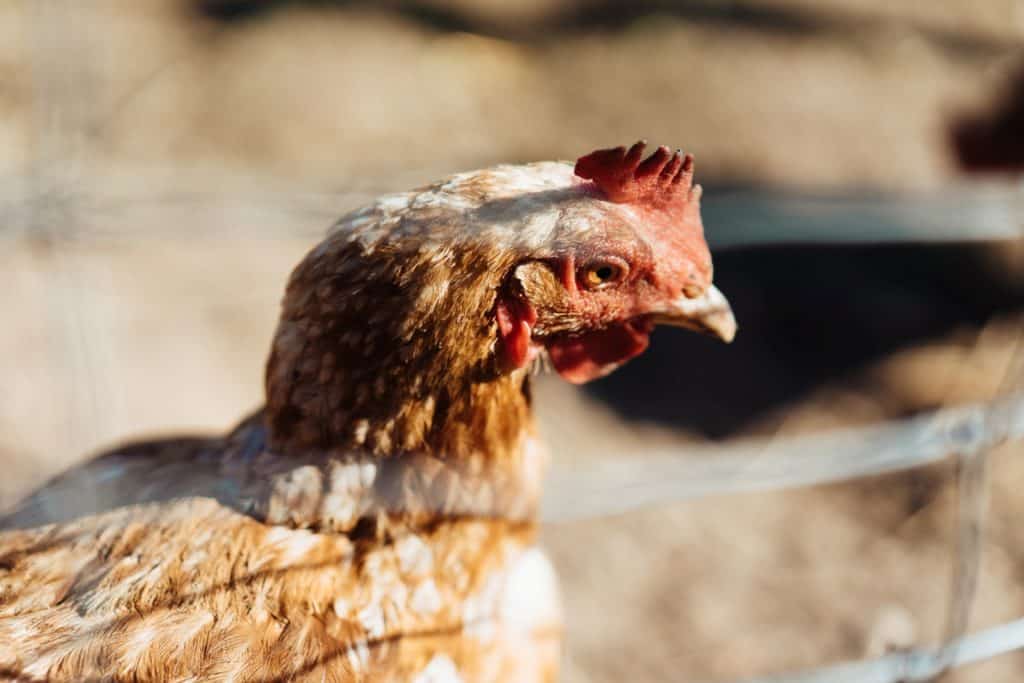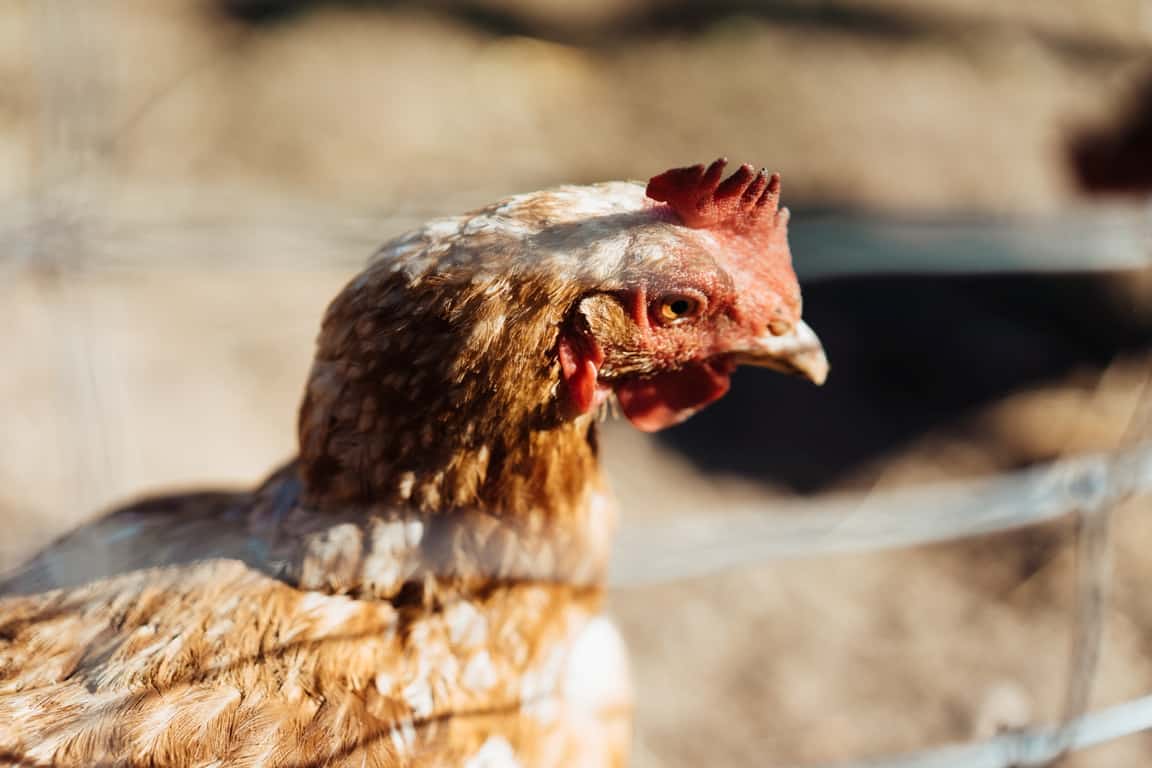
Ever ask why is my chicken losing its feathers? Walking out to your coop in the morning and seeing feathers all over the place can be a jarring sight.
When I first started raising backyard chickens years ago the question popped up and I had to know the answer.
So why do chickens molt? I did some research and this is what I found.
Chickens began to molt after they have reached the age of 18 months. They molt to replace worn or damaged feathers. During this molting period, chickens will experience feather loss followed by a regrowth of feathers. A molting chicken transfers her energy to growing feathers instead of laying eggs. A molt usually occurs during fall.
- Learning about why chickens molt
- How do chickens act when they are molting?
- Will all my chickens molt at the same time?
- Is molting painful for chickens?
- Can molting kill a chicken?
- What do you feed molting chickens?
- When chickens molt do they stop laying eggs?
- How long do chickens molt and not lay eggs?
- How long do chickens molt for?
- Do roosters molt?
- How long do chickens molt for?
- Do molting chicken’s get cold?
- Conclusion
Learning about why chickens molt
When the days get shorter and light decrease this a sign to the chicken’s biological clock that winter is coming. Your chicken will start molting to replace worn and damaged feathers.
Having strong new feathers for winter will help keep your chickens insulated from the cold. A hen’s feathers help provide a warm layer of insulated air trapped in their down between their feathers and body.
According to the Murry Mcmurray hatchery chickens experience their first molt when they are 6 to 8 days old called the “juvenile” molt. During this period baby chicks will lose their down cover replacing it with new feathers.
The baby chicks will go through partial molts at 7 to 9 weeks, the next molt will be at 12 to 16 weeks, and a final molt before becoming an adult is at 20 to 22 weeks.
Male chickens while experience a second molt during the juvenile phase when they are about 8-12 weeks old. During this time his ornamental feathers will come in.
Once the chicken has reached 18 months their first adult molt will occur. The molt and regrowth can last for a period between 8 and 12 weeks for most chickens. Chickens began to molt as the days grow shorter and summer turns to fall.
An adult chicken will undergo one molt per year. The chicken can experience a hard molt or a soft molt. During a soft molt, the chicken will slowly lose feathers over a period of weeks and is not as noticeable.
You will see a hard molt when you see a chicken has lost a large number of feathers. You chicken could appear almost naked or show a lot of skin on their neck area.
During the molt, a chicken will lose its feathers and regrow new ones over a period of weeks. When the molting process starts can depend on when the hen first started laying eggs.
When Do Chickens Molt?
When chickens are approximately 18 months old, molting first occurs. Feathers should fall out and grow back in 8 to 16 weeks for backyard flock owners, but some chickens may take longer.
How do chickens act when they are molting?
The molting period is a natural process of a chicken’s life cycle. Your chicken should act normal during this process. If they are acting strangely for an extended period of time they could have an illness.
Will all my chickens molt at the same time?
No, your chickens will not all molt at the same time. Each chicken’s body is on its own timetable. Each one may start and end new feather growth at a slightly different time. Depending on the size of your flock the whole process could take 3 months or more.
Is molting painful for chickens?
Yes, the molting period can be painful for chickens. Hens often don’t like to be held while their experiencing feather loss and regrowth. The reasons are their newly formed pin feathers are sensitive to the touch.
You should not pick up any of your hens when they are molting as it can make them uncomfortable.
Can molting kill a chicken?
Molting is a natural part of a chicken’s life cycle. It does not kill your chicken. However, your chicken could be losing feathers for other reasons such as stress, lack of the right nutrients, or mites.
Mites can cause a chicken to lose feathers make them anemic and ultimately cause death in some cases.

What do you feed molting chickens?
When your chickens are molting you should cut back on the chicken scraps. Make sure your hens are getting higher levels of protein in their food than they normally would with a layered feed.
The standard layer feed contains 16% protein content. You should temporarily switch or mix in a high protein feed. One of the best to use is broiler feed that normally contains at least 20-22% protein.
Your chicken’s feathers are made up of 97% protein. This extra protein helps the molting chicken build new feathers faster and helps with the hen’s overall diet during this time.
You do not want to feed them this much protein too long as it can damage their long term health.
Another option to increase your hen’s protein intake is to feed them mealworms. These snacks contain 20% protein. They are a great protein treat for your hens to munch on. A couple more options you can feed them include black oil sunflower seeds and tuna fish.
You should also make sure they have plenty of water available to drink. You can add supplements to their water to help ensure digestion and overall gut health.
If your hens are typically kept in a small run you can free-range them during the molting period. This will allow them to access a wider area to eat bugs and grubs to supplement their diet.
When chickens molt do they stop laying eggs?
Yes, your chickens will stop laying eggs as they molt. This is because their body will redirect the energy used to lay eggs into growing new feathers.
They can’t grow new feathers and lay eggs at the same time. You will have no egg production from your hen during the molting time period.
How long do chickens molt and not lay eggs?
Adult chickens molt for a period of 8-12 weeks. Once the molting process is completed your hen should start laying eggs again. At this point you can switch back to a layered feed in the 16% protein range.
How long do chickens molt for?
Chickens typically molt for about 8-12 weeks but it can last as long as 6 months. This time frame encompasses the entire molting process from a loss of feathers to a complete feather regrowth.
A chicken’s tail feathers are usually the last area to experience regrowth.
Do roosters molt?
Yes, roosters molt just as hens do. The rooster will shed its feathers and grow new ones. This molting process usually happens during Autumn. It can take 8 weeks or more to complete the process.
How long do chickens molt for?
A Chicken typically completes the molting process in about 8 to 16 weeks during fall. Molts occur in both hens and roosters. During this period they can lose feathers on their neck, head, body, and tail.
Do molting chicken’s get cold?
No molting chickens do not get too cold in most cases. They start the molting process in the fall so they have plenty of time to regrow new feathers. These new feathers will keep them warm during the winter months.
Chickens and birds in general have survived cold weather for thousands of years. Remember birds live outside all year long and their bodies are designed to withstand the elements and survive during the winter months.
Conclusion
Hopefully, you now better understand why chickens molt. Seeing feathers all over the place can be a worrying sight. When you see your hen’s molting make sure it is the right time of year and there are no other possible underlying conditions.
Keep your hens safe and happy egg collecting!

